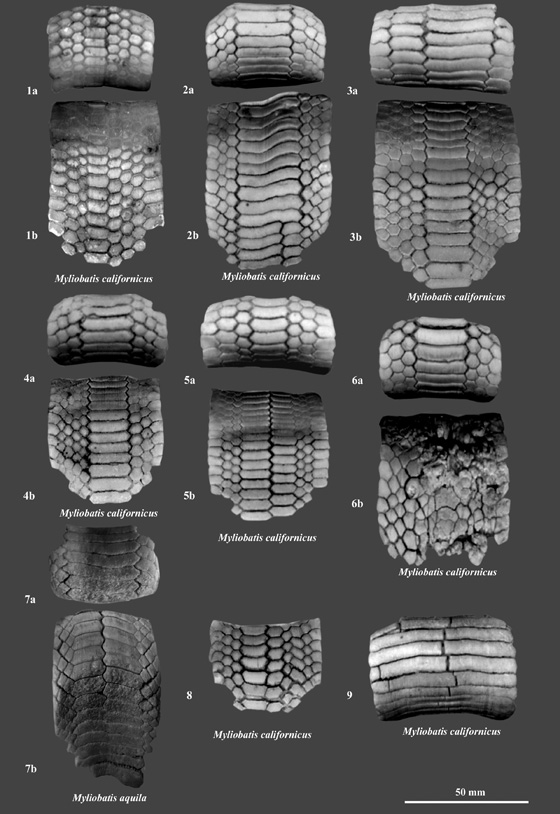
|

|
PALAEONTOS 24Price: non-members: 40 euros ; members: 35 euros Hovestadt D.C. & Hovestadt-Euler M., 2013, Generic assessment and reallocation of Cenozoic Myliobatins based on new information of tooth, tooth plate and caudal spine morphology of extant taxa. ISSN: 1377-4654(66 textpages, 3 textfigures, 5 tables, 51 platesSummary: The results of a comprehensive comparative study of tail spine and dental morphology of extant Myliobatinae has lead to new information, that is described and illustrated in Part I. Tail spine morphology appeared to be unsuitable for both generic as well as specific distinction. There exist nine tooth morphological variations and several abnormalities in the tooth plates of Myliobatis, four variations in Pteromylaeus and four in Aetobatus. Further the dental morphology of the four Aetomylaeus species are extensively investigated for the first time, revealing their exclusive ontogenetic heterodonty, absent in the other Myliobatinae. The dental morphology of Myliobatinae appears to allow generic distinction. The tooth morphology of isolated teeth of several specimens of Myliobatis aquila, Myliobatis goodei, Aetomylaeus vespertilio, Aetomylaeus nichofii, Aetobatus narinari and Pteromylaeus bovinus are described and illustrated revealing new information about the locking mechanism of the teeth and additional information about granulated crown surfaces. All fossil Pliocene, Miocene, Oligocene, Eocene and Paleocene Myliobatinae previously mentioned in literature are described and illustrated as far as possible in Part II, including photographs of previously un-illustrated taxa, which are compared with the variations of extant taxa used as morphotypes to group tooth plates with similar dental morphologies. The Oligocene Weissobatis micklichi and the Eocene Promyliobatis gazolai are considered skeleton developments of the Myliobatis-lineage, respectively. 180 nominal Cenozoic species comprise 23 species based on tail spine morphology, 2 fossil species based on skeleton details, as well as tooth morphology, 139 species on isolated teeth, tooth fragments, tooth plates or tooth plate fragments. There are 16 nominal species for which there are no descriptions, illustrations, or holotypes, 23 based on tail spine morphology, and 19 poorly preserved, lacking sufficient characteristic detail, which are rejected. Although extant material strongly indicates that at least taxa of the genus Myliobatis and Aetobatus cannot be specifically distinguished and thus their fossil ancestors may not be valid, further investigation is needed to confirm this observation, including Aetomylaeus and Pteromylaeus. The nominal species are generically reassigned of which 16 species belong to the genus Aetobatus, 17 to Aetomylaeus, 32 to Myliobatis and 50 to Pteromylaeus. Extraordinary developments like granulation of the crown surface, present in several variations of Cenozoic Myliobatinae, appear to be natural developments, also found in extant species. Elevation of the crown centre was observed in some fossil species and is considered as abnormality. Pitting of both crown surface and root, found in some fossil species is considered the result of external, post-mortem influences. Rhinoptera daviesi Woodward, 1889, Burnhamia fetahi Cappetta, 1985 and Myliobatis monnieri Cappetta, 1986 have tooth morphologies also found in species of Myliobatis. One tooth of Myliobatis plicatilis Davis, 1888 is referred to Rhinoptera and Mobula glickmani Pfeil, 1981 is considered to belong to Mobulinae. Eomobula stehmanni Herman, Hovestadt, Hovestadt-Euler, 1989, Meridiania convexa Case, 1994, Apocodon sericeus Cope, 1885, Garabatis atlasi Cappetta, 1993, and Lophobatis phosphaticus Cappetta, 1986, as well as two remaining teeth of Pseudaetobatus casieri Cappetta, 1986 do not possess the characteristic dental morphology of the Myliobatinae. They are considered to represent early developments of Myliobatidae. |
|
ORDER INFORMATION:please contact us at: palaeontos@gmail.com |
|